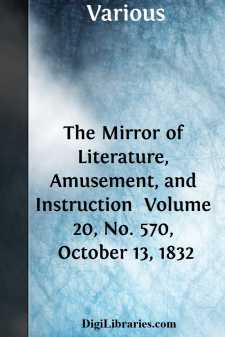Categories
- Antiques & Collectibles 13
- Architecture 36
- Art 48
- Bibles 22
- Biography & Autobiography 813
- Body, Mind & Spirit 142
- Business & Economics 28
- Children's Books 17
- Children's Fiction 14
- Computers 4
- Cooking 94
- Crafts & Hobbies 4
- Drama 346
- Education 46
- Family & Relationships 57
- Fiction 11829
- Games 19
- Gardening 17
- Health & Fitness 34
- History 1377
- House & Home 1
- Humor 147
- Juvenile Fiction 1873
- Juvenile Nonfiction 202
- Language Arts & Disciplines 88
- Law 16
- Literary Collections 686
- Literary Criticism 179
- Mathematics 13
- Medical 41
- Music 40
- Nature 179
- Non-Classifiable 1768
- Performing Arts 7
- Periodicals 1453
- Philosophy 64
- Photography 2
- Poetry 896
- Political Science 203
- Psychology 42
- Reference 154
- Religion 513
- Science 126
- Self-Help 84
- Social Science 81
- Sports & Recreation 34
- Study Aids 3
- Technology & Engineering 59
- Transportation 23
- Travel 463
- True Crime 29
The Mirror of Literature, Amusement, and Instruction Volume 20, No. 570, October 13, 1832
by: Various
Categories:
Description:
Excerpt
THE ISLE OF WIGHT.
(Wilkes's Cottage.)NOTES FROM A PEDESTRIAN EXCURSION IN THE ISLAND.
By a Correspondent.
Although the roads of the island have within the last twenty years been rendered passable for vehicles of all kinds, even to stage coaches, yet by far the best mode of inspecting this English Arcadia is to travel through it on foot, commencing at Ryde.
From this town a footpath leads across the park and grounds of St. John's into the high road which may be followed to Brading. About a mile from that place is Nunwell, the seat of Sir W. Oglander; and opposite is a delightful view of Bembridge (the birthplace of Madame de Feuchares) and Brading Harbour, which at high water presents to the eye a rich, deep, green colour, with an increased effect from being surveyed through the long line of tall elms on the road side. Brading boasts of a mayor and corporation, and formerly sent a member to parliament, which privilege was abolished by Queen Elizabeth. The town is of high antiquity, as is also the church, which tradition says was the first built in the island. It contains few monuments of interest or note, but the surrounding burial-ground can boast of a collection of epitaphs and inscriptions which are above mediocrity. The following to the memory of Miss Barry by the Rev. Mr. Gill has been rendered celebrated by the admirable music of Dr. Calcott:
Forgive, blest shade, the tributary tear,
That mourns thy exit from a world like this;
Forgive the wish that would have kept thee here,
And stayed thy progress to the realms of bliss.
No more confined to grov'ling scenes of night—
No more a tenant pent in mortal clay;
Now should we rather hail thy glorious flight,
And trace thy journey to the realms of day.
On a rising ground at the end of the town is the Mall; at the entrance of which the earth reverberates to the tread of horses' feet in a manner similar to that produced by riding over a bridge or hollow. It is most probably occasioned by a natural cleft in the chalk beneath the gravel road. Here the tourist should rest to enjoy a scene of unrivalled beauty. On the left, below the road, lies the town of Brading, and more remote, St. Helen's Road, and the opposite coasts of Portsmouth and Southsea. In front, at the foot of the hill, are the rich levels, with the sinuous river Yar slowly winding towards the harbour, with the full broad front of Bembridge Down interrupting the marine view, which is again presented on the right from the village of Sandown to the extremity of Shanklin. At the foot of Brading Hill the road divides itself into two branches. The one to the right leads direct to Shanklin, over Morton Common: the other to the left lies through Yarbridge to Yaverland and Sandown. We recommend the latter, as the farm-house and church at Yaverland are worthy of notice. The former is a fine capacious stone building, of the time of James I., containing some well executed specimens of carved oak. The church is annexed to the house, and has a curious semicircular doorway....












